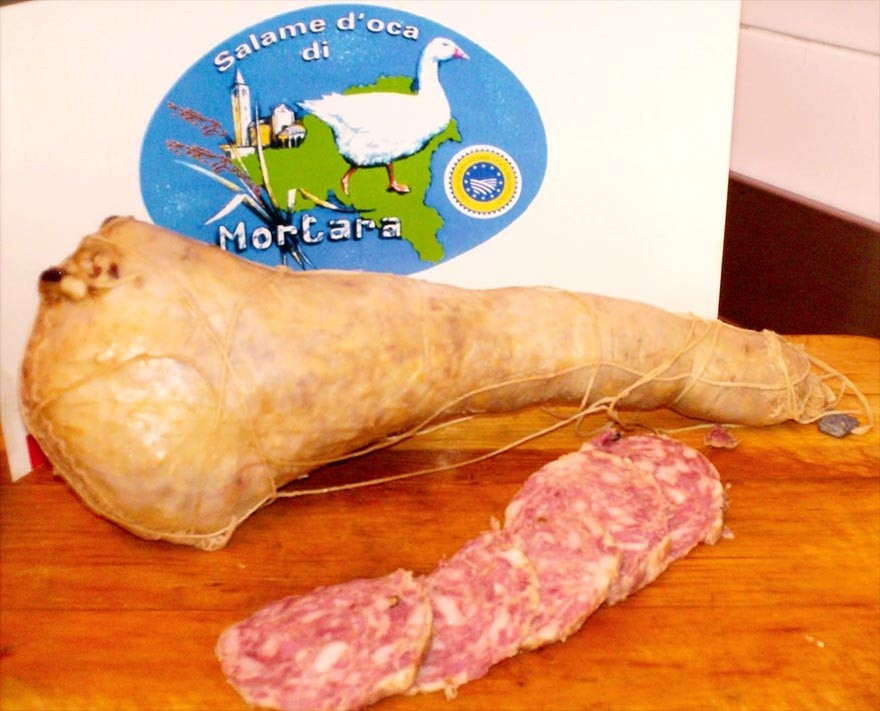Salami duck from Mortara P.G.I.
Description
Salame d’Oca di Mortara PGI is a cooked charcuterie product stuffed in goose skin, made of chopped goose meat with lean meat and pork fat, mixed together to form a consistent, homogenous and compact mincemeat.
Production Method
During the last three months of their lives, the geese are fed exclusively on green forage and grains.
The goose meat and pork are minced using a mincer with 8-10 mm holes, after which, the paste is seasoned with marine salt, pepper and various natural aromas.
The mince is inserted into salted goose skin, then trimmed and closed. The salami is pierced, tied and left to dry for 1-3 days in ventilated environments with temperatures varying from 14 to 18°C.
It is cooked in heated compartments with a medium temperature of 80°C and then cooled.
Appearance and Flavour
Salame d’Oca di Mortara PGI has a tubular or goose neck shape, depending on whether the mince is encased in the skin of the neck, back or stomach of the animal.
When cut, the casing should remain attached to the meat. The sweet and delicate flavour is characteristic of goose meat and the aroma is fine and mild, due to the presence of spices.
Gastronomy
It is best to keep Salame d’Oca di Mortara PGI in the fridge. Once sliced, it should be wrapped in aluminum foil.
Salame d’Oca di Mortara PGI is a fundamental ingredient for starters and cold nibbles and is perfect to pair with mellow, aromatic white wine.
It is also excellent diced in hot dishes, mashed potatoes and vegetables.
Marketing
The product is marketed as Salame d’Oca di Mortara PGI. It is sold whole, sliced, hermetically sealed or vacuum-packed.
Distinctive Features
Salame d’Oca di Mortara PGI is the result of the fusion of different gastronomic cultures: the food habits of the Jewish population, which led to the introduction of goose meat, united with those of the local non-Jewish population, who were accustomed to eating pork-based products.
History
It is said that the origins of Salame d’Oca di Mortara PGI are found within the history of the Jewish community in Lomellina, following an order by Ludovico Sforza that authorised their establishments.
It fact, Jewish families were the first to order goose salami and scratching from the local butchers.
However, it seems that the goose meat was not sufficient enough to satisfy the tastes of a large part of the non-Jewish inhabitants in the area, so several local butchers added the lean and fatty parts of pig.
However, it was the creativity of the Mortarese masters that was responsible for the invention of Salame d’Oca di Mortara as it is known today.
Local tales cite the presence of goose salami in the 1780’s, although concrete evidence of the diffusion and sale of this product can only be found in the early XX century.
In fact, official recognitions demonstrating the appreciation of the product outside of the Lomellina area date back to this period, such as the gold medal given to Salame d’Oca di Mortara by Master Butcher Carlo Orlandini, on the occasion of the Second International Exposition in Paris in 1916.
Production Area
The production area of Salame d’Oca di Mortara PGI is the municipal areas of Lomellina, a geographical area in the Province of Pavia, in the Lombardy region.
The animals must be born, raised and slaughtered in the regions of Lombardy, Piedmont, Emilia-Romagna, Veneto and Friuli Venezia Giulia; the geese can also come from the Trentino Alto Adige region, while the pigs can also be raised and slaughtered in the regions of Abruzzo, The Marches, Lazio, Molise, Tuscany and Umbria.
Operators: 5
Production(KG): 1.190
Turnover(MLN€): 0,03

 IT
IT 